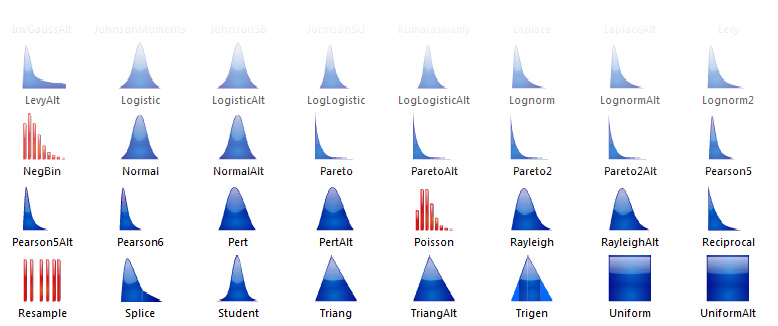
What is a Monte Carlo simulation?
Monte Carlo techniques were developed during World War II. To create atomic weapons, complex mathematics related to probability distributions were used. Several decades later this technology was refined and is now used by the largest corporations and institutions in the world for different purposes.
The 21st century business environment is complex and rapidly changing. To succeed requires a ‘telescope and microscope’ approach: seeing the big picture but also being able to zoom-in on small details when needed. Monte Carlo simulations can provide business with sophisticated tools to master business planning, and maximize profitability.
Taking its name from the world-renowned casino town in Monaco, Monte Carlo is not a product. It is a collection of techniques that allows businesses to view all possible outcomes of a venture through statistical simulations.
Casinos, being filled with games of chance, were an excellent application of the mathematics for modelling and assessing uncertainty in the outcomes of these games. Monte Carlo simulations work by creating thousands – sometimes millions – of trials and seeing the outcomes that emerge from them. This is in contrast to an earlier and simpler method that required very restrictive and often unrealistic assumptions on its input parameters.
An everyday example
As an example, consider the time it takes for a car to travel between two cities. The model would have two inputs: the weather and time-of-day (peak and off-peak demand). In addition to these variables, two other parameters are distance and average speed. For the weather variable, a probability distribution of various weather states (rain, snow, fog, clear skies) and for traffic, its own probability distribution (low, medium, high traffic).
Generation of these probability distributions stem from historical data and/or objective expert measures – meteorologist and civil engineers. Combining all these inputs, Monte Carlo simulations generates a range of travel times and the corresponding likelihood of each time between the cities.
A Monte Carlo simulation would run through various scenarios covering all the different cases. For example, one case would be rainy weather and high traffic. Another case would be rainy weather and medium-level traffic. The travel time from these outcomes and the probability would then be computed.
All this information culminates in a full spectrum of possibilities for the decision-maker, and any one of these scenarios can be analyzed more closely. For example, observing the combination of holiday season and weather may produce unusual results and require closer investigation by the model design team.
Monte Carlo and the bottom line
There are many innovative uses of Monte Carlo simulations to generate additional revenue and differentiate products in the market. As an example, we developed an application that featured Monte Carlo analysis for a U.S. health insurance client to improve the effectiveness of their customer’s health coverage.
The client sells insurance products such as critical illness, long-term disability, medical, dental, and vision coverage through their agent network. One of the most important concerns for critical care coverage is the risk of personal bankruptcy in the event of a sustained medical condition. A customer will have a budget in mind but won’t know how much insurance they need to manage their risk.
The application we developed asks simple questions from the customer such as their age, weight, smoking history and other health factors. They also provide their current budget and expenditures with each insurance coverage area.
A Monte Carlo simulation can be run that simulates thousands of possible probabilities and paths to determine the potential health outcomes and the associated costs depending on different levels of coverage, to determine their risk of bankruptcy. The customer gets an easy-to-understand report that shows them the risks of their current product mix and suggests ways to optimize or increase their coverage to minimize potential financial hardship, resulting in increased revenues and lower risks for the insurer.
Although it requires millions of calculations, this simulation can be completed in just a few seconds. Just a few years ago, this type of system would be too costly to implement, but with the advent of Cloud Computing platforms, such as Amazon Web Services or Microsoft Azure, high-performance servers can be accessed nearly instantly and the calculations can be completed quickly with low cost.
Monte Carlo: the ‘Cook Book’ approach
Consider the following scenarios:
- A change in minimum wage
- A change in corporate tax rate
- A change in depreciation or accounting rules
- A disruption to your supplier network
Consider the familiar adage, ‘failure to plan is planning to fail.’ Any of the above scenarios could happen and understanding the full impact on your operations will be imperative to your success. Risk management for small and medium-sized (SMEs) business does not need to be guesswork. Monte Carlo simulations provide a scientific approach which has been proven useful to many organizations.
While modelling complex situations may require outside expertise, SMEs can use common office programs like Microsoft Excel and the widely available @Risk application to add structure to their risk-management.
The first step is to identify what key variables affect a risky situation. Next, consider the likely values that these variables could take. Formally, in statistics, this is called a probability distribution. Some examples of distributions are below:

The final step is to have a program calculate all the different combinations the variables can take and the interaction of these different combinations across variables.
As part of ongoing human capital growth, SME executives should explore the benefits of adding Monte Carlo simulations to their business planning.






disqus comments